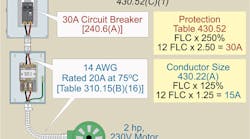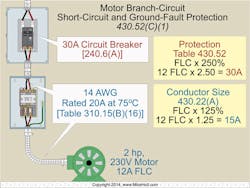Stumped by the Code? NEC Requirements for Sizing Short Circuit and Ground Fault Protection for Single Motor Branch Circuits
Q. What is the Code rule for sizing short circuit and ground fault protection for a single motor branch circuit?
A. The motor branch circuit, short circuit and ground fault protective device must comply with the requirements of Sec. 430.52(B) and Sec. 430.52(C). As noted in 430.52(B), a motor branch circuit short circuit and ground fault protective device must be capable of carrying the motor’s starting current. As noted in 430.52(C)(1), each motor branch circuit must be protected against short circuit and ground faults by a protective device sized no greater than the percentages listed in Table 430.52 (Table).
Let’s run through an example problem to show you how this is done.
What size conductor and inverse time circuit breaker are required for a 2-hp, 230V, single-phase motor with 75°C terminals (Figure)?
Step 1: Determine the branch circuit conductor [Table 310.15(B)(16), 430.22, and Table 430.248]:
12A × 1.25 = 15A
A quick check of Table 310.15(B)(16) reveals that a 14 AWG conductor is rated 20A at 75°C
Step 2: Determine the branch circuit protection [240.6(A), 430.52(C)(1), and Table 430.248]:
12A × 2.50 = 30A
I know it bothers many in the electrical industry to see a 14 AWG conductor protected by a 30A circuit breaker, but branch circuit conductors are protected against overloads by the overload device, which is sized between 115% and 125% of the motor nameplate current rating [430.32]. The small conductor rule contained in Sec. 240.4(D), which limits 15A protection for 14 AWG, doesn’t apply to motor circuit protection. See Sec. 240.4(D) and
Sec. 240.4(G). With that being said, there is an exception.
Exception No. 1: If the motor short circuit and ground fault protective device values derived from Table 430.52 don’t correspond with the standard overcurrent device ratings listed in Sec. 240.6(A), the next higher overcurrent device rating can be used.
This next example illustrates this point.
What size conductor and inverse time circuit breaker are required for a 7½-hp, 230V, 3-phase motor with 75°C terminals?
Step 1: Determine the branch-circuit conductor [Table 310.15(B)(16), 430.22, and Table 430.250]:
22A × 1.25 = 27.50A
A quick check of Table 310.15(B)(16) reveals that a 10 AWG conductor is rated 35A at 75°C.
Step 2: Determine the branch-circuit protection [240.6(A), 430.52(C)(1) Exception No. 1, and Table 430.250]:
22A × 2.50 = 55A, next size up = 60A






